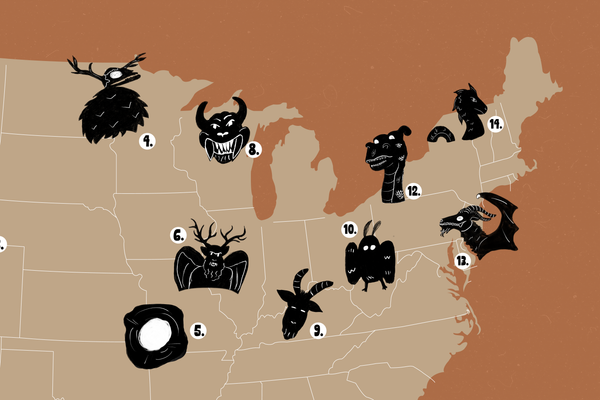Tanuki the Tipsy Trickster: Why a Well-Endowed Raccoon Dog Is Big in Japan
A Tanuki far from home, in Brisbane, Australia (photograph by the author)
The signs and symbols of Japan can be disorientating, as Western signage such as the striped barber’s pole and the green/red man of traffic lights is blended with more traditional symbols, such as the hanging drapes that indicate onsen (traditional baths), the red-caped kitsune (fox-gods), and jizo (statues of dead children, dressed to stay warm against the cold of the grave.)
One of the more curious symbols is the tanuki, a raccoon dog that represents a traditional Japanese prankster god. The tanuki is known in the West best from Super Mario Brothers 3, which features a tanuki suit that allows Mario to change form into a statue and to fly, as well as from the Studio Ghibli film Pom Poko, which is about a gang of tanuki (although in the English language version of the film they were misrepresented as badgers.)
The real tanuki (photograph by Emily/Flickr user)
Tanuki in Shigaraki, Japan (photograph by akaitori/Flickr user)
The tanuki has a mixed reputation in Japan. Statues of the full-bellied (and large-testicled) tanuki can be found throughout Japan, even if pollution and urban sprawl have taken their toll on the actual animal after which the trickster takes its name and form. The tanuki is a shape-shifter, and his testicles play an important role in his shifting. Tanukis have legendarily been known to use their testicles as makeshift raincoats, as weapons, and as drums. They knead and massage them into the shape they desire, and often impersonate humans to buy alcohol and delicacies, which is where the tanuki fits into modern Japanese culture.
Myths and legends surrounding the tanuki are commonplace around Japan — the mischievous creature’s antics even feature in a traditional Japanese children’s song (sung, for some reason, to the tune of an old Baptist hymn): “Tan Tan Tanuki no kintama wa/Kaze mo nai no ni/Bura bura.” The lyrics translate as: “Tan-tan, the Tanuki’s testicles ring/the wind has stopped blowing/but still they swing-swing.”
1881 tanuki woodblock print by Yoshitoshi (via Wikimedia)
Tanuki using his testicles as a rain coat, from an 1841 illustration by Takehara Shunsensai (via Honolulu Museum of Art)
Tanuki using their testicles as nets in an 1840 illustration by Utagawa Kuniyoshi (via pinktentacle.com)
Tanuki illustration (via Wikimedia)
A tanuki illustration from the Edo period by Kawanabe Kyōsai (via Wikimedia)
The earliest appearance of a tanuki in Japanese folklore comes from the Nihon Shokai (The Chronicles of Japan), which deals mostly with Japanese mythology. It was written in 720, and the chapter about the Empress Suiko expressly mentions the tanuki: “in two months of spring, there are tanuki in the country of Mutsu, they turn into humans and sing songs.” The tanuki also appears in the Nihon Ryōiki (written around 780 CE) and the Shūi Monogatari (written in the 13th century) — these works mention more of the tanuki’s magical abilities: its shape-shifting, whether into human or animal forms, the ability to possess human beings, and its love of pranks.
Famous tanuki myths that have found their way into Japanese culture include that of the Bunbuku Chagama, which roughly translates as “happiness bubbling over like a tea pot.” Bunbuku Chagama tells the story of a peasant who finds a tanuki caught in a trap. He sets it free, and the tanuki decides to repay him for the favor. It transforms into a tea pot, and the peasant sells him to a Buddhist monk. Unable to stand the heat, the tanuki half-transforms back into its original form, and runs back to the peasant’s house. Together they make a fortune, as the half-tanuki, half-teapot performs tricks to make a living.
A tanuki taxidermy (photograph by FuFuWolf/Flickr user)
Taxidermied Tanuki at Morinji Temple, of Bunbuku Chagama fame (photograph by Namazu-tron/Wikimedia)
The Soko-tanuki is the story of a tanuki, who, disguised as a monk, goes to work in a temple. After many years of hard work, the tanuki was caught mid-nap in its original form. Rather than chase the trickster away, the monks instead rewarded its hard work by giving it the rank of a page and allowing it to stay in the temple. In 1795, if reports are to be believed, a tanuki masquerading as a samurai made its way into a Nagasaki brothel, and proceeded to take full advantage of all the services on offer. He was eventually discovered, again while sleeping, and was forcibly removed from the premises. All of the money he had used inside the brothel turned into dried leaves as he left the site. There is also the story of the Bozu-tanuki, who inhabits a bridge in Handa, on the island of Shikoku — if you cross his bridge the tanuki will shave your hair with a straight razor.
Using their shape-shifting abilities, the tanuki will try and pass off leaves or scraps of paper as money in exchange for goods, and the ceramic statuettes are left outside restaurants and bars in particular, in an attempt to trick the tricksters into believing that they or one of their kind have already visited the store in question. They also have a reputation of bringing wealth to a business, an association that has stuck through the ages due to a little bit of ancient Japanese word-play. Craftsmen in the medieval period used tanuki pelts to soften their hammer blows while shaping gold-leaf, and the association doesn’t end there. Kin-tama, which literally translates as “gold balls,” which was the Japanese euphemism for the body-part for which tanukis are most famous.
Christmas tanuki (photograph by rumpleteaser/Flickr user)
Tanuki crossing sign (photograph by Federico/Flickr user)
Discover more of the mythological creatures of the world on Atlas Obscura.












Follow us on Twitter to get the latest on the world's hidden wonders.
Like us on Facebook to get the latest on the world's hidden wonders.
Follow us on Twitter Like us on Facebook